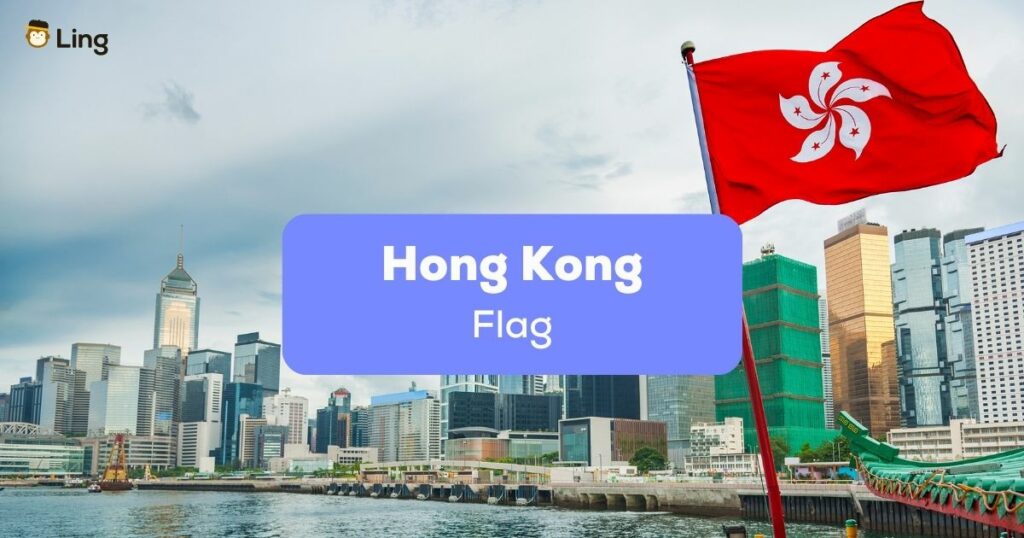Can you imagine how weird it must be if none of the countries have their own national flag (or 旗 – kei4 in Cantonese)? Fortunately, that is not the case in today’s world.
In fact, all the national flags today carry some or the other symbolic meaning. In line with that, we will unlock astonishing facts about the Hong Kong flag in this post today. So, read on!
Importance Of The National Flags
A national flag symbolizes a nation’s pride, identity, and patriotism. It is a positive confirmation of devotion and dedication. It identifies a country that believes in. Its design and colors represent countries in various ways, identifying their values, beliefs, and history. Initially, it might have simply been a part of decorations or perhaps ceremonial images during ancient times. But this concept has evolved entirely through time.
Flags became essential and symbolic to the country’s image. Leaders, communities, gods, commerce, artisan guilds, ships, and towns were all represented by flags. A flag was frequently treated with the same reverence as the person or thing it signified. Even in battles, the loss of a flag was a devastating blow. Capturing an opponent’s flag could be the game’s deciding factor. Religious symbols were also frequently depicted on flags and hoisted at religious and state events.
At present, a national flag usually represents a country’s intangible and tangible qualities. The geographical location, or possibly a distinguishing physical feature, historical foundation, or (to a lesser extent) the constitutional system are some examples of such qualities. And with this concept in mind, let’s now learn about the regional Hong Kong flag.
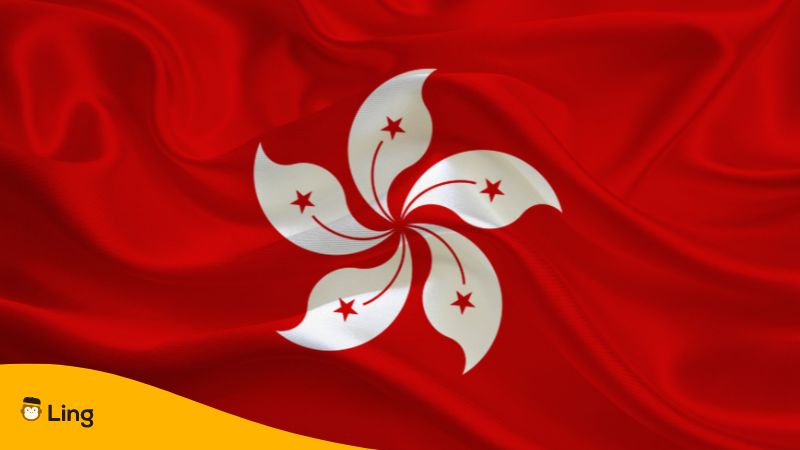
Brief History Of The Hong Kong Flag
Hong Kong, officially known as the Hong Kong Special Administrative Region of the People’s Republic of China, is one of the special administrative regions of China. Even though they are under the administration of China, Hong Kong has its own flag.
Hong Kong’s flag has a stylized five-petaled white orchid against a red background. Since 1997, it has served as Hong Kong’s official flag, signifying the city’s reunification with China under the principle of “one country, two systems.”
There are different Hong Kong flags used: the pre-colonial flag, colonial flags, and flags used by government departments. During the Japanese colonization of Hong Kong, they forcibly introduced Japanese lifestyles in, eradicating many parts of Chinese and British culture. During this time, the identity of Hong Kong was suppressed, and all British and Chinese flags were banned; propaganda posters were issued proclaiming the Japanese flag to be Hong Kong’s national flag.
Before adopting the current flag, Hong Kong’s colonial flag was a ‘Blue Ensign’ flag, which featured Hong Kong’s coat of arms on a white disk on the outer part of the blue Union Jack ensign. The flag was used between 1959 and 1997. Two Chinese junks, a nautical crown, and a lion holding a pearl were featured in the design, alluding to Hong Kong’s nickname “Pearl of the Orient.”
Between 1987 and 1988, before the handover of sovereignty from the United Kingdom to the People’s Republic of China (PRC), a competition was held in the Chinese city to design a new flag for post-colonial Hong Kong. Residents of the city submitted almost 4,000 drawings; however, none were accepted by the PRC government. Instead, they invited renowned architect Tao Ho, one of the panel’s assessors, to pick Hong Kong’s new flag.
The Hong Kong flag has an interesting backstory. Ho entered a garden in search of inspiration and picked up a bauhinia flower. He saw the five petals’ symmetry and how their twisted petals gave off a vibrant vibe. Finally, he brought out this vitality into the flag to represent Hong Kong. This became the post-colonial Hong Kong SAR flag.
On February 16, 1990, Hong Kong’s flag was officially adopted. The Preparatory Committee, a panel that advised the People’s Republic of China, gave it formal approval on August 10, 1996. (PRC). On July 1, 1997, it was officially hoisted during Hong Kong’s handover ceremony.
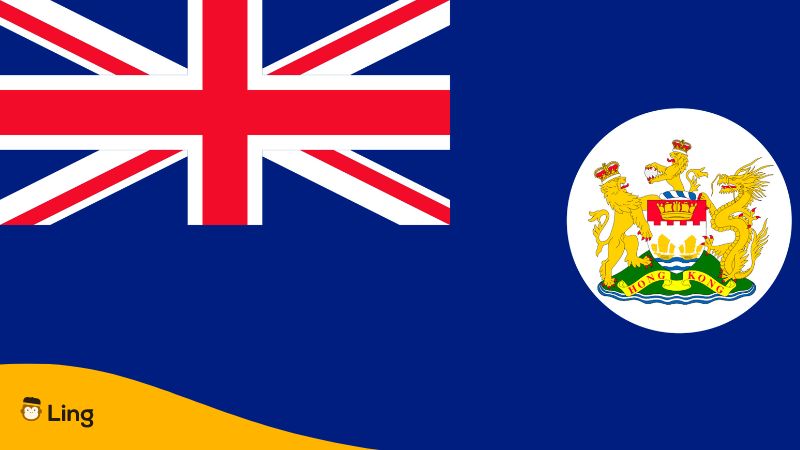
All About Hong Kong’s National Flag
Hong Kong’s flag might look simple, but all of its elements have meanings. Every part of Hong Kong symbolizes the identity and values of Hong Kongers; that’s why it is governed by laws passed. The flag’s design is entrenched in Hong Kong’s Basic Law, the territory’s constitutional document. The Regional Flag and Regional Emblem Ordinance specify the flag’s use, use ban, flag desecration, and flag fabrication.
The Hong Kong government has established the flag’s dimensions, colors, and production requirements. In this part of the blog, we will learn more about every part of Hong Kong’s flag.
1. Design And Symbolism
The current flag of Hong Kong features a bright red background with a circular arrangement of white flower petals. This contemporary design was adopted by the Fourth Plenum of the Hong Kong Special Administrative Region’s Preparatory Committee on August 10, 1996, and it is currently used until now.
Color
The Chinese flag represents the motherland. As we all know, red is a joyful color in China. It is used in many important celebrations, and it is also used to express nationalism and festivity. The red background added to the Hong Kong flag came from the motherland, represented by the Chinese flag. The inclusion of the color red in the flag of Hong Kong is used to symbolize the connection between Mainland China and Hong Kong.
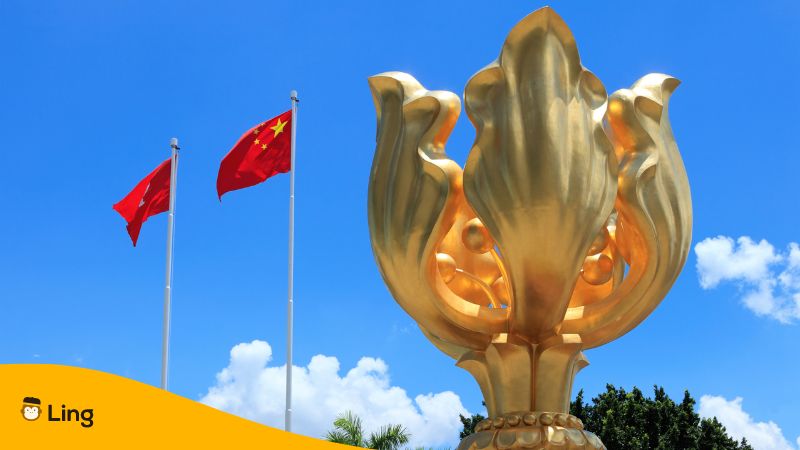
Bauhinia Blakeana Flower
The emblematic flower of the flag of Hong Kong was from the Bauhinia Blakean (紫荊 zi2 ging1), often known as the Hong Kong Orchid Tree. The fragrant, violet flowers are grown across the city and bloom from November to late March. The flower is depicted in white on the flag as a symbol of peace and harmony. There is also a statue of this plant in the Golden Bauhinia Square that you might want to visit in Hong Kong.
Five Stars
The flag of Hong Kong also has a five-pointed star in each of the flower’s petals. The five-pointed red star is a replica of the five stars Chinese national flag and a symbol of the ruling Communist Party. The five stars on the flower also represent the Hong Kong compatriots’ love they have for their homeland.
Size
The flag of Hong Kong has a specific size depending on its use. It must be a scaled-down or scaled-up variant of one of the official sizes if a flag is not of official size. Here is a list of all the official sizes for the flag.
- 1 – 288 cm × 192 cm
- 2 – 240 cm × 160 cm
- 3 – 192 cm × 128 cm
- 4 – 144 cm × 96 cm
- 5 – 96 cm × 64 cm
- Car flag – 30 cm × 20 cm
- Flag for signing ceremonies – 21 cm × 14 cm
- Desktop flag – 15 cm × 10 cm
2. Construction And Manufacture Regulations
The flag of Hong Kong has specified sizes, colors, and manufacturing parameters, and here are the things that you need to remember:
- Length: It has a length-to-breadth ratio of 3:2.
- Bauhinia blakeana flower: A five-petal stylized representation of a white Bauhinia blakeana flower sitting in the center point. If a circle is used to round the flower, it should have a diameter of 0.6 times the flag’s height. The petals are evenly distributed around the flag’s center point, extending outward and oriented clockwise.
- Stars: A five-pointed red star with a red trace appears on each flower’s petals, resembling a flower stamen.
- White is the heading that allows a flag to be slid or raised onto a pole.
- The Regional Flag and Regional Emblem Ordinance mandate that the Hong Kong flag be produced in accordance with the ordinance’s criteria.
- If flags are not manufactured following the ordinance’s design, the Secretary of Justice may seek an order from the District Court prohibiting the individual or company from producing flags. If the District Court determines that the flags are out of compliance, it may issue an injunction and order the government to take them and the materials used to construct them.
3. Protocols
The flag is treated with great respect considering what it symbolizes. Even if it’s not your country’s flag, you should show your respect as if it is your own. The precise use of the flag is governed by legislation established by the State Council’s 58th executive meeting in Beijing. Here are some protocols regarding the flag of Hong Kong.
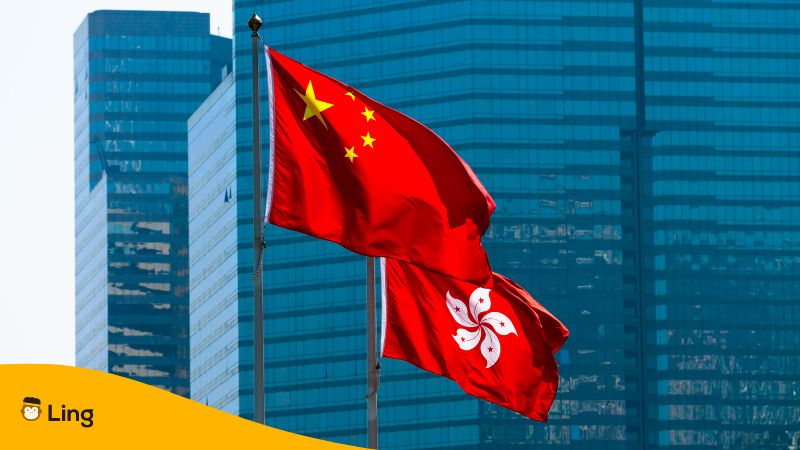
Display
- The national flag of the People’s Republic of China must be flown in the center, above the regional flag, or in a more prominent position than the regional flag.
- The regional flag must be smaller and to the left of the national flag. When a flag is displayed indoors, the left and right sides of a person looking at it with their back to the wall are utilized as reference points.
- When exhibited indoors, the flag should be to the speaker’s right or podium (observers’ left). If not, the flag is positioned to the audience’s right.
- Flags must have a saffron stripe when displayed. The hoist cord should be at the top and the saffron stripe to the left if hung vertically behind the podium.
- When exhibited outside with other national flags, the Regional Flag must be on a separate pole to the right (viewer’s left). Then, the flags are grouped by their English names. All flags must be the same size as the Hong Kong flag.
- The Regional Flag can be flown at the beginning, end, or middle of the row. The Regional Flag should be flown from a major point when flown in a circle. Flags should be raised clockwise around the Regional Flag. The Regional Flag is raised first and lowered last.
- When displayed on crossed poles, the Regional Flag is to the right (observers’ left). The Regional Flag can be flown on either side of the UN flag. The flag is usually on the right (i.e., farther-most left of an observer facing the flags).
- The Hong Kong flag is flown daily at all border crossings and points of entry into Hong Kong, including the chief executive’s official house, Government House, and the Hong Kong International Airport.
- During working days, the national and regional flags are displayed at significant government offices and buildings such as the Office of the Chief Executive, the Executive Council, the Court of Final Appeal, the Legislative Council, and the Hong Kong Economic and Trade Offices overseas.
- On certain occasions, such as National Day (1 October), Hong Kong Special Administrative Region Establishment Day (1 July), and New Year’s Day, other government offices and buildings, such as hospitals, schools, departmental headquarters, sports grounds, and cultural venues, can fly the national and regional flags.
Raising And Lowering Of The Flag
- At 8:00 a.m., the flag should be raised. At 6:00 p.m., the flag must be lowered. The flag should be raised and lowered slowly: when raised, it must reach the top of the flagstaff, and when dropped, it must not touch the ground. In inclement weather, the flag may not be raised.
Ceremonies And Parades
- The flag should be on the right or front and center in a procession or parade. The flag can be displayed at the unveiling of a statue, monument, or plaque, but not to cover it.
- During a flag hoisting or lowering ceremony, march, or review, everyone must face the flag. Those in uniform will also salute. Moving column flags follow the same principles. A dignitary can salute without a headcover. Following flag raising and saluting, play the national anthem.
Multi-Sports Events
There is also a different protocol for the flag of Hong Kong during the Olympics. Suppose a Hong Kong athlete wins gold and a mainland Chinese athlete wins silver or bronze in the same event. In that case, the regional flag of Hong Kong will be raised in the center above the national flag(s) during the medal presentation ceremony.
Half-Staff
- When any of the following people pass away, the Hong Kong flag must be lowered to half-staff as a mark of respect.
- President of the People’s Republic of China
- Chairman of the Standing Committee of the National People’s Congress
- Premier of the State Council
- Chairman of the Central Military Commission
- Chairman of the National Committee of the Chinese People’s Political Consultative Conference
- Persons who have made outstanding contributions to the PRC. (As the Central People’s Government advises the Chief Executive)
- People who have made remarkable contributions to international peace or the cause of human growth. (As the Central People’s Government advises the Chief Executive)
- Persons whom the Chief Executive believes to have made remarkable contributions to the Hong Kong Special Administrative Region or for whom the flag should be flown at half-staff.
- The Regional Flag may also be flown at half-staff if the Central People’s Government instructs the Chief Executive to do so or if the Chief Executive deems it suitable after sad events causing large casualties or natural calamities.
Desecration, Prohibition, And Disposal
- The Regional Flag and Regional Emblem Ordinance prohibit specific uses of the Hong Kong flag and desecration of the flag; both are serious offenses.
- A Hong Kong flag that is torn, defaced, faded or substandard may not be exhibited or used.
- According to the regulation, a flag cannot be used in ads or trademarks and “publicly and willfully burning, mutilating, scrawling on, defiling or stomping” it is flag desecration.
- When a flag is no longer in good enough shape to be used, it should be thrown away respectfully, preferably by burning it.
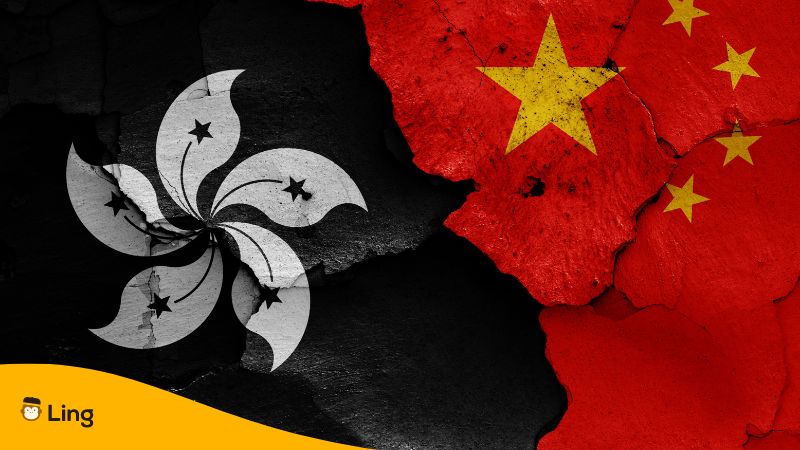
Flags Used At The 2019 Hong Kong Protests
Aside from the pre-colonial, colonial, and post-colonial flag of Hong that you saw, there is also another flag of Hong Kong that is used in protests against the Chinese government. Let’s look at them.
1. Black Bauhinia
Twenty-two years after it was initially flown, the flag and flower emblem has been targeted by pro-democracy demonstrators. Last July 1, 2019, demonstrators hoisted an upside-down Hong Kong flag at a ceremony marking the territory’s transfer to China. The Chinese national flag and an ominous black version were flown at half-staff in sorrow.
2. Lennon Wall flag
The Lennon Wall Flag, a symbol of Hong Kong’s pro-democracy movement, was designed by the Chinese cartoonist and political activist Badiucao. According to Badiucao, the flag was directly inspired by Hong Kong’s Lennon Wall. It comprises 96 colored squares organized in an eight by 12 grid to represent the post-it notes on the walls. He asserts, “Each color on the flag represents a distinct voice. And every voice deserves a home in Hong Kong.” The number 96 denotes 1996, the year preceding Hong Kong’s transfer of sovereignty.
Cantonese Words And Phrases Related To The Hong Kong Flag
Learn More Cantonese With Ling!
The Hong Kong flag symbolizes the nation’s pride and patriotism, but the country’s national language is it’s essential identity. Without one language, it’s hard to bind people together. So, after learning about the flag of Hong Kong, why not try to learn the Cantonese language too?
But where to begin? Luckily, Ling can give you a fun and extensive language learning experience. With fun activities and well-developed lessons, you can improve your language skills in record time. So, simply download the app from the App Store or the Play Store, and start learning with Ling now!
